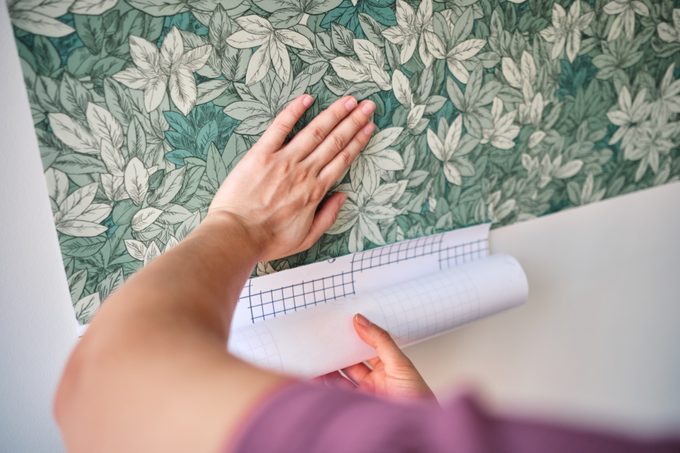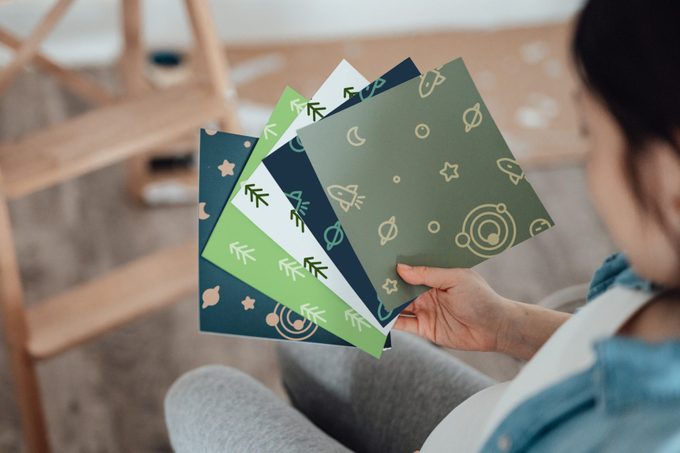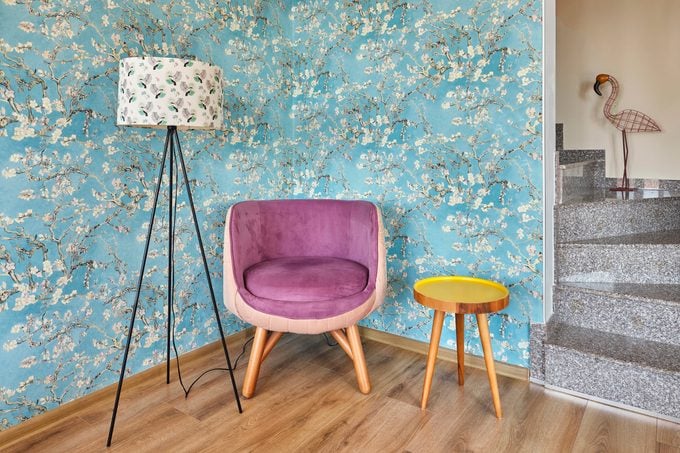Wallpaper is part of a long tradition of considering walls as works of art.
“Psychologically we have a thing about putting our views, our thoughts, our feelings on the walls,” says Carol Miller of York Wallcoverings. “From the time of cave paintings forward, we have used our walls to express ourselves.”
But while beautiful patterns draw people to wallpaper, the makeup of the wallpaper keeps that art on the wall, lasting as long as a cave painting.
Wallpaper consists of two equally important parts:
-
The backing: This dictates how the wallpaper attaches to the wall. The technical term is the substrate.
-
The front: This determines the wallpaper’s look and how heavy-duty, colorfast and washable it is. The technical term is the front of sheet.
Wallpapers can have any mix of front material and backing.
To help you make an informed wallpaper choice, we asked Miller, James Greenwood of Graham & Brown and Robin Patrick of Roman Products for their insights on the pros and cons of different backing and front materials.
Non-pasted: Non-woven or Paste-the-Wall Backing
Non-woven backings are made of pressed paper fibers, a little like a paper felt.
With this backing, you apply paste to the wall like paint, then stick the wallpaper on top. Non-woven papers can be applied this way because the backing material doesn’t shrink once it’s wet.
Pros
-
Easy installation for DIYers. It’s less messy and faster than more traditional “paste-the-paper” backing because you don’t need to pre-measure and pre-cut papers before putting them on the wall. You can hang it while it’s on the roll, then trim.
-
You can slide this wallpaper around on the wall a little after placing it, which is helpful for pattern matching.
Cons
-
You must use the type of paste meant for your wallpaper. Check the wallpaper label to determine the specific type of paste to use. Getting the right paste is imperative to keeping the wallpaper stuck to the wall and making removal easier later.
-
Messier than peel-and-stick wallpaper.
Non-pasted: Paste-the-Paper Backing
This is the most traditional type. You apply the paste to the wallpaper, not the wall, because this type of backing will contract slightly once the paste is applied.
Pros
-
A traditional way of applying wallpaper.
Cons
-
You must use the correct paste for your wallpaper.
-
Messiest application.
-
Best for an advanced DIYer or a professional.
Pre-Pasted Backing
This has chemicals on the back you wet to activate the paste. Miller says traditional methods of soaking pre-pasted wallpaper can oversaturate the paper and result in a messy application. Misting the backing makes application easier and less messy.
Pros
- You never have to worry whether you bought the right or wrong paste.
-
You avoid applying wallpaper paste, saving a step.
Cons
-
Can be messy.
Peel-and-Stick Backing

Peel-and-stick wallpaper comes with adhesive on the back that requires no activation. Peel off a protective backing and it’s ready to stick to your wall. It’s often paired with a vinyl front.
Pros
-
No messy paste.
-
Few tools needed for application — a utility knife, smoothing tool and maybe a putty knife.
Cons
-
If the pattern doesn’t line up as you install this paper, you need to lift it from the wall and put it down again. You can’t slide it around like a non-woven paste-the-wall wallpaper.
-
Pattern can stretch slightly if you peel off the backing too fast.
-
Older peel-and-sticks tended to peel off the wall quickly or stick too well. Today’s manufacturers solved most of these problems.
Vinyl Front
Heavy-duty and long-lasting, this type is a hard-working product that’s the most washable type. Greenwood says it can last decades.
Vinyl also has some antimicrobial properties, Miller says. “You’ll see vinyl wallpaper in hotels, restaurants and hospitality because it’s more durable than paint,” she says,
Miller adds there are different weights of vinyl wallpaper and recommends the heavy-duty Type II product to get all of vinyl’s benefits.
While vinyl wallpaper is generally washable, check for a scrubbable washability rating if heavy-duty cleaning is a priority. There are some differences in wallpaper material if it’s rated as “scrubbable” versus standard vinyl wallpaper.
Pros
-
Heavy-duty, washable and colorfast.
-
One of the less expensive wallpaper materials.
-
Typically the longest-lasting wallpaper material.
Cons:
-
Heavy-duty vinyl can require heavy-duty paste.
Paper Front

Various paper fronts and printing techniques can be used, like screen printing or digital printing, Greenwood says. That means paper wallpaper comes in many styles, from shiny and glossy to slightly textured.
Pros
-
Wide variety of looks and styles.
-
Generally washable.
Cons
-
Not as washable or heavy-duty as vinyl.
Grasscloth Front
Grasscloth wallpaper is a natural material made of different grasses woven together. It’s a high-end wallpaper with a natural texture.
Note: Grasscloth is a material, but it can also refer to a pattern that mimics natural grasscloth. Double-check the material if you’re looking for authentic grasscloth.
Pros
-
Popular, high-end product.
-
Made of natural materials.
Cons
-
Hard to work with. Consider a professional installer.
-
Not colorfast.
-
Not scrubbable.
-
Expensive.
Paintable Front
Paintable wallpaper has a raised design or texture and is meant to be painted. It can cover a damaged wall, and you can customize the color or easily refresh it by painting it a new color.
Painting other types of wallpaper can make it harder to remove. But modern paintable wallpaper lets the seams reappear with steam, so Greenwood says it can be removed.
Pros
-
Hides damage on walls.
-
Easily adds texture to walls.
-
The second most durable wallpaper after vinyl.
-
Easy to refresh by painting it a new color.
Cons
-
Layers of paint could eventually hide the pattern. You may need to dry brush or use another faux painting technique to make the pattern stand out, Miller says.
-
Usually inexpensive, comparable to vinyl, but you must add the cost of painting it.
Fabric, Beaded or Flocked Front
These are high-end products. They tend to add plush accents to a home, Greenwood says.
Pros
-
Special, luxurious look.
-
Typically the most expensive wallpaper materials.
Cons
-
Require care to apply. Hire a professional installer.
-
They’re delicate and must be cleaned carefully.
-
Expensive.
Foil or Metal Front
Foil or metal wallpapers aren’t common. They tend to be thin and can be damaged easily.
If you like the idea of foil, though, some wallpapers with metallic ink used on other materials have a shiny look without an actual metal front.
Pros
-
Distinct look.
Cons
-
Tend to be fragile.
-
Difficult to install.
-
Expensive.
Cork Front
Cork is a natural material that can be dyed any color. “It’s natural, it’s beautiful. It has interest because of all these natural holes in the cork itself,” Miller says.
Pros
-
Natural, sustainable product.
Cons
-
Expensive.
-
Can be hard to work with. Consider hiring a professional installer.
More Pro Tips

-
Keep your project in mind. If wallpaper is going in a high-traffic area like a busy hallway where it may be bumped, go for a heartier wallpaper. If it’s going behind a headboard in a bedroom, Greenwood says, it can be more delicate.
-
Read the wallpaper’s directions before you buy, and again before you begin installation. Wallpaper companies test to make sure their instructions will help your wallpaper last longer and come off more easily later. “We test and test, and then we test again,” Miller says. “We’ve done the legwork for you.”
-
When you’re deciding whether to hang wallpaper yourself or hire a pro, consider how complicated the pattern is, the sturdiness of the paper and how much you paid for it, Patrick says. If you’re not confident you can do it, hire a pro.
Article source here: Guide To Different Types of Wallpapers


No comments:
Post a Comment